A framework to assess the impact of number of trials on the amplitude of motor evoked potentials
- PMID: 33293541
- PMCID: PMC7722939
- DOI: 10.1038/s41598-020-77383-6
A framework to assess the impact of number of trials on the amplitude of motor evoked potentials
Abstract
The amplitude of motor evoked potentials (MEPs) elicited by transcranial magnetic stimulation (TMS) is a common yet highly variable measure of corticospinal excitability. The tradeoff between maximizing the number of trials and minimizing experimental time remains a hurdle. It is therefore important to establish how many trials should be used. The aim of this study is not to provide rule-of-thumb answers that may be valid only in specific experimental conditions, but to offer a more general framework to inform the decision about how many trials to use under different experimental conditions. Specifically, we present a set of equations that show how the number of trials affects single-subject MEP amplitude, population MEP amplitude, hypothesis testing and test-retest reliability, depending on the variability within and between subjects. The equations are derived analytically, validated with Monte Carlo simulations, and representatively applied to experimental data. Our findings show that the minimum number of trials for estimating single-subject MEP amplitude largely depends on the experimental conditions and on the error considered acceptable by the experimenter. Conversely, estimating population MEP amplitude and hypothesis testing are markedly more dependent on the number of subjects than on the number of trials. These tools and results help to clarify the impact of the number of trials in the design and reproducibility of past and future experiments.
Conflict of interest statement
The authors declare no competing interests.
Figures



References
Publication types
MeSH terms
LinkOut - more resources
Full Text Sources
Miscellaneous

